新目标初一英语unit7教案
- 格式:docx
- 大小:16.56 KB
- 文档页数:3
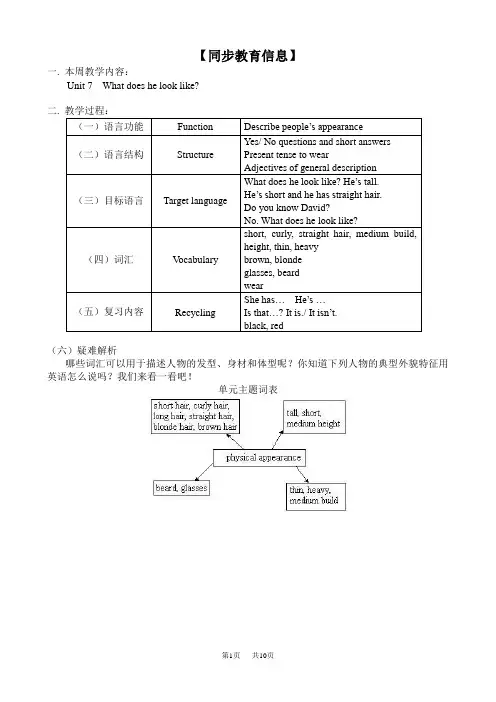
【同步教育信息】一. 本周教学内容:Unit 7 What does he look like?二.(六)疑难解析哪些词汇可以用于描述人物的发型、身材和体型呢?你知道下列人物的典型外貌特征用英语怎么说吗?我们来看一看吧!单元主题词表1. —What does your friend look like?你的朋友长什么样?—She is medium build, and she has long hair.她中等身材,长头发。
(1)look like是固定词组,意思是“看起来像”,通常指外表的长相。
有时也说be like。
like是介词,意为“像……样”。
如:The moon looks like a small boat. 月亮看起来像小船。
(2)medium build意思是“中等身材”。
如:He is a man of strong build. 他是一个体格健壮的男人。
(3)long hair“长头发”。
hair在这里是不可数名词。
如果指一根一根的毛发,可作可数。
如:He had his hair cut yesterday. 他昨天去理了发。
2. 形容词的用法。
形容词一般在句中可作定语、表语、宾语补足语。
如:This is a red flag. 这是面红旗。
I’m glad to meet you. 见到你,我很高兴。
I found the book very interesting. 我发现这本书非常有趣。
形容词在修饰不定代词时,放在不定代词之后。
如:There is something new in today’s newspaper.今天的报纸上有些新东西。
但有些形容词只能作表语,不能作定语,它们常称为表语形容词。
如:afraid, ill, asleep, awake, alone, alive, unable等。
The little girl is afraid of dogs. 这个小女孩怕狗。
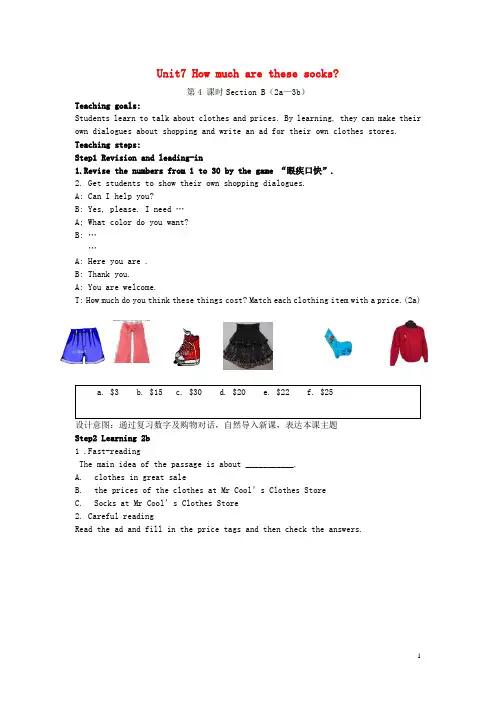
Unit7 How much are these socks?第4 课时Section B(2a—3b)Teaching goals:Students learn to talk about clothes and prices. By learning, they can make their own dialogues about shopping and write an ad for their own clothes stores. Teaching steps:Step1 Revision and leading-in1.Revise the numbers from 1 to 30 by the game “眼疾口快”.2. Get students to show their own shopping dialogues.A: Can I help you?B: Yes, please. I need …A; What color do you want?B: ……A: Here you are .B: Thank you.A: You are welcome.T: How much do you think these things cost? Match each clothing item with a price.(2a)a. $3b. $15c. $30d. $20e. $22f. $25Step2 Learning 2b1 .Fast-readingThe main idea of the passage is about ___________.A. clothes in great saleB. the prices of the clothes at Mr Cool’s Clothes StoreC. Socks at Mr Cool’s Clothes Store2. Careful readingRead the ad and fill in the price tags and then check the answers.Clothes PricesGreen sweaters $15Yellow sweaters $12Trousers $22Shorts $16Skirts $20Jackets $30Shoes $28Socks $23. Inquiry into knowledge by translation(1)Come and buy your clothes at our great sale!我们在大甩卖,快来买衣服吧!祈使句常用来表示说话人的愿望、意志、请求、警告、命令、号召获建议等,其主语you通常省略。
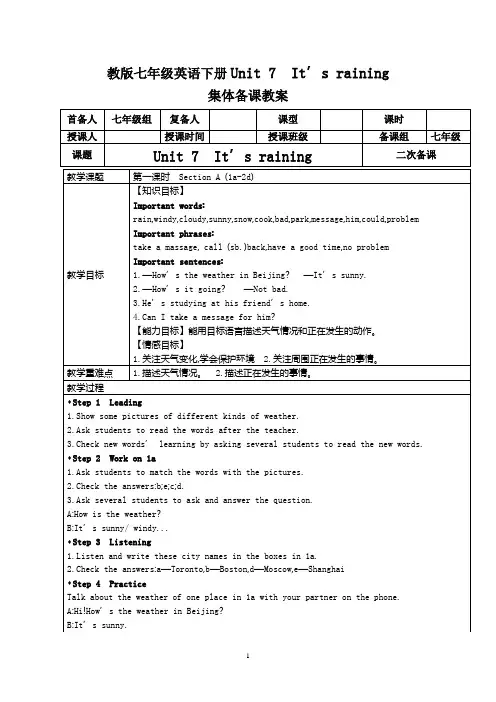

Unit 7 How much are these socks?The First PeriodSection A (1a-2e)Ⅰ.Teaching aims:1.Knowledge aims:(1)Keywords:much,sock,T-shirt,shorts,sweater,trousers,shoe,skirt,dollar,big,small,sho rt,long,woman,need,look,pair,take(2)Key phrases:how much,how about,look nice,two pairs(3)Important sentences:①—How much is this T-shirt?—It’s seven dollars.②—How much are these socks?—They’re two dollars.③—Can I help you?—Yes,please.④—What color do you want?—Blue.⑤—How about this one?—It looks nice.⑥I’ll take it.⑦—I’ll take two pairs.—Here you are.2.Ability aims:Talk about clothing and prices.3.Emotion aims:Develop students’ abilities in their lives when going shopping.II.Important points:Learn to read and spell new words about clothes.III.Difficult points:Be able to ask and answer questions using “How much is...?”or “How muchare...?”.IV.Teaching processStep 1 Lead-in1.T:Hi,everyone!Do you like going shopping?Ss:Yes,we do.T:Let’s go shopping together,OK?(Show them a picture of a store.)Look,there are so manybeautiful clothes here,tell me which kind of clothes you can see.S1:Socks/Shorts/Shirts/Sweaters/Shoes...2.Ask and answer.The teacher ask a student:①Which clothes do you like?②What color is it?3.Let students practice saying the colors and the phrases: “a red hat/a small yellow hat/a shortbrown T-shirt...”Step 2 Practice1.Work on 1a.①Match the words with the things in the picture.Then check the answers.②Let Ss read the whole things in the picture together and try to memorize them.2.Work on 1c.Choose one student to be a shopkeeper and another is a customer.Ask and answer:①—How much is this T-shirt?—It’s ... dollars.②—How much are these socks?—They’re ... dollars.3.Work on 2d.Practice the conversations by using the dialogue in the right table.Choose two students to act it out.Step 3 Listening1.Work on 1b.Let students listen and circle the things they hear in the picture in 1a.2.Work on 2a.Listen to the recording and repeat after it.3.Work on 2b.Listen to the conversations and circle the things you hear.4.Work on 2c.Listen again,fill in the price tags.Then check the answers.Step 4 Role-play1.Watch the video and read after it by yourselves.2.Role-play the conversation in front of the whole class.3.Answer the following questions.①What does Mary want to buy?②What color does she want?③How much are the socks?4.Check the answers.Language points1.How much is this T-shirt?这件T恤衫多少钱?(教材第37页)“How much...?”在此用来提问物品的价格,意为“……多少钱?”相当于“How much money...?”询问表示单数意义商品的价格,用“How much is...?”,答语用“It’s+价格.”;询问表示复数意义商品的价格,用“How much are...?”,答语用“They’re+价格.”—How much is the book?这本书多少钱?—It’s two dollars.2美元。
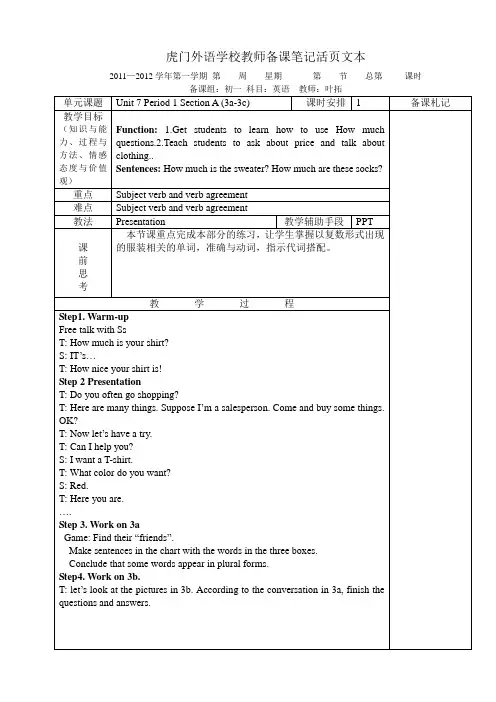
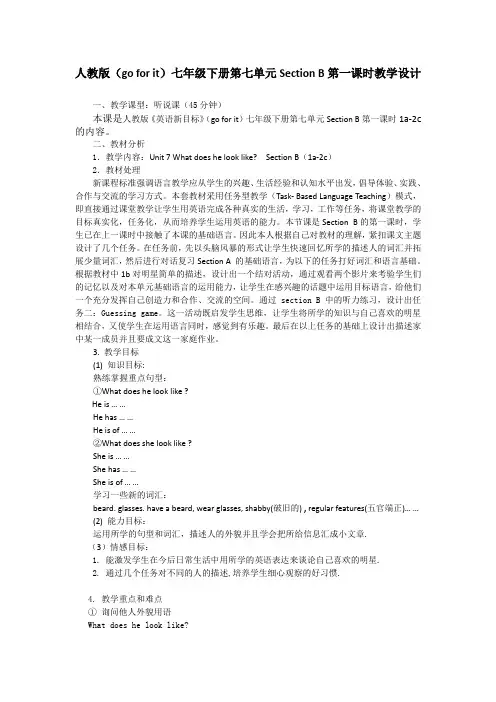
人教版(go for it)七年级下册第七单元Section B第一课时教学设计一、教学课型:听说课(45分钟)本课是人教版《英语新目标》(go for it)七年级下册第七单元Section B第一课时1a-2c 的内容。
二、教材分析1.教学内容:Unit 7 What does he look like? Section B(1a-2c)2.教材处理新课程标准强调语言教学应从学生的兴趣、生活经验和认知水平出发,倡导体验、实践、合作与交流的学习方式。
本套教材采用任务型教学(Task- Based Language Teaching)模式,即直接通过课堂教学让学生用英语完成各种真实的生活,学习,工作等任务,将课堂教学的目标真实化,任务化,从而培养学生运用英语的能力。
本节课是Section B的第一课时,学生已在上一课时中接触了本课的基础语言。
因此本人根据自己对教材的理解,紧扣课文主题设计了几个任务。
在任务前,先以头脑风暴的形式让学生快速回忆所学的描述人的词汇并拓展少量词汇,然后进行对话复习Section A的基础语言,为以下的任务打好词汇和语言基础。
根据教材中1b对明星简单的描述,设计出一个结对活动,通过观看两个影片来考验学生们的记忆以及对本单元基础语言的运用能力,让学生在感兴趣的话题中运用目标语言,给他们一个充分发挥自己创造力和合作、交流的空间。
通过section B 中的听力练习,设计出任务二:Guessing game。
这一活动既启发学生思维,让学生将所学的知识与自己喜欢的明星相结合,又使学生在运用语言同时,感觉到有乐趣。
最后在以上任务的基础上设计出描述家中某一成员并且要成文这一家庭作业。
3. 教学目标(1) 知识目标:熟练掌握重点句型:①What does he look like ?He is ……He has ……He is of ……②What does she look like ?She is ……She has ……She is of ……学习一些新的词汇:beard. glasses. have a beard, wear glasses, shabby(破旧的) , regular features(五官端正)……(2) 能力目标:运用所学的句型和词汇,描述人的外貌并且学会把所给信息汇成小文章.(3)情感目标:1. 能激发学生在今后日常生活中用所学的英语表达来谈论自己喜欢的明星.2. 通过几个任务对不同的人的描述,培养学生细心观察的好习惯.4. 教学重点和难点①询问他人外貌用语What does he look like?What does she look like?What do they look like?②描述他人外貌用语He/She is tall/ …… .He/She has short hair/…… .He/She is of medium height/…… .三,教学设计1. 总体思路本节课是Section B第一课时听说课,学生已在Section A中接触了本课的基础语言,因此本课重点培养学生口头运用语言的能力。

Unit 7 How much are these socks?SectionA (1a-2e)Teaching aims〔教学目标〕1. 能理解并区别以下单词:much, socks, T-shirt, shorts, sweater, trousers, shoe, skirt, dollar ,big, small, short, long, woman, need, look, pair, take2. 能理解并正确使用以下句型:How much is ?How much are ?Can I help you?Yes, please. I need a sweater forschool.I’ll take it.Here you are.Thank you.You’re welcome.3. 能熟练谈论物品的价格。
学会询问物品的价格 ,谈论衣物的价格。
Language points〔语言点〕1.要求掌握以下句式:-How much is this T-shirt? -It’s seven dollars.-How much are these socks? –They’re two dollars.Can I help you? Yes, please. I need a sweater for school.What color do you want?I’ll take it .Thank you. You’re welcome.2. 要求掌握以下单词:much, socks, T-shirt, shorts, sweater, trousers, shoe,skirt, dollar, big, small, short, long, woman, need, look, pair, take教学重难点谈论物品的价格运用英语语言进行购物。
Teaching steps〔教学步骤〕1. Greetings2. Revision复习以下句型What is this? It’s a ….What color is it? It’s ….What are these? They’re ….What color are they? They’re….为了吸引同学们的注意力 ,加强课堂教学的生动性 ,趣味性 ,提高学习效率 ,这里可以用一些和颜色有关的图片或实物。
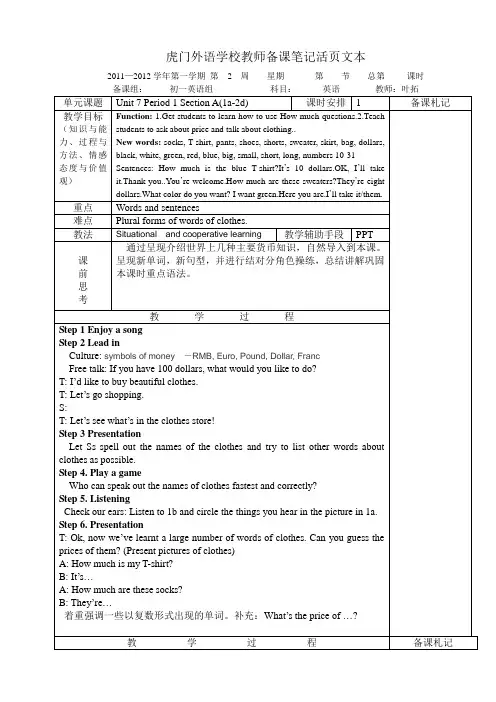

七上英语第七单元教案简单教学目标:1. 知识与能力:学生能够掌握本单元的重点词汇和语法知识,能够正确运用所学知识进行听、说、读、写等方面的语言运用。
2. 情感态度价值观:通过本单元的学习,培养学生对英语学习的兴趣,增强学生的自信心,激发学生学习英语的积极性。
3. 学科交叉:通过本单元的学习,培养学生的观察、分析和解决问题的能力,提高学生的语言综合运用能力。
教学重点难点:1. 重点:掌握本单元的重点词汇和语法知识,能够正确运用所学知识进行听、说、读、写等方面的语言运用。
2. 难点:培养学生的观察、分析和解决问题的能力,提高学生的语言综合运用能力。
教学过程:一、导入(5分钟)通过播放一段与本单元主题相关的视频或图片,激发学生对本单元主题的兴趣,引导学生进入学习状态。
二、学习新词汇(10分钟)1. 教师给学生介绍本单元的重点词汇,并通过图片、音频等方式帮助学生掌握单词的发音和意义。
2. 学生跟读单词,加深记忆。
三、学习新语法(15分钟)1. 教师通过例句或对话的方式向学生介绍本单元的语法知识,如动词的时态、形容词的比较级和最高级等。
2. 学生进行语法知识的操练,加深理解。
四、听力训练(15分钟)1. 教师播放与本单元相关的听力材料,要求学生听懂内容,根据问题进行回答。
2. 学生进行听力训练,提高听力理解能力。
五、口语训练(15分钟)1. 教师设计相关的口语练习题目,要求学生进行口语练习,如对话、情景对话等。
2. 学生进行口语练习,提高口语表达能力。
六、阅读训练(15分钟)1. 教师布置相关的阅读材料,要求学生阅读并回答问题。
2. 学生进行阅读训练,提高阅读理解能力。
七、写作训练(15分钟)1. 教师设计相关的写作练习题目,要求学生进行书面表达。
2. 学生进行写作训练,提高书面表达能力。
八、复习总结(5分钟)1. 教师对本节课的学习内容进行复习总结,强化学生对知识点的记忆。
2. 学生进行知识点的复习总结,巩固所学知识。
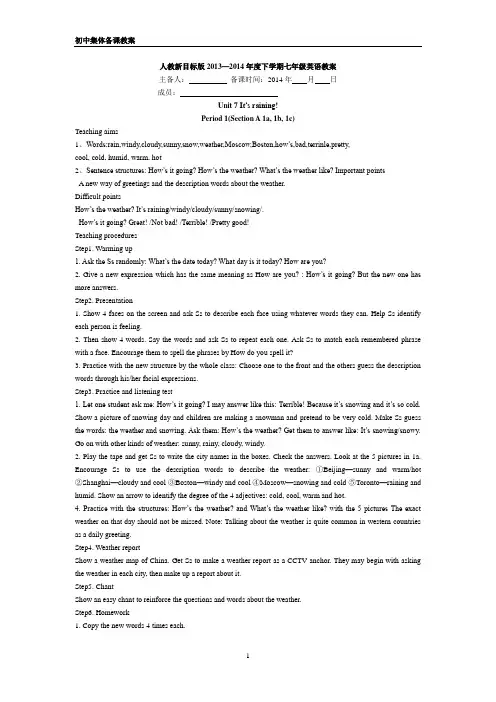
人教新目标版2013—2014年度下学期七年级英语教案主备人:备课时间:2014年月日成员:Unit 7 It’s raining!Period 1(Section A 1a, 1b, 1c)Teaching aims1、Words:rain,windy,cloudy,sunny,snow,weather,Moscow,Boston,how’s,bad,terrinle,pretty,cool, cold, humid, warm, hot2、Sentence structures: How’s it going? How’s the weather? What’s the weather like? Important pointsA new way of greetings and the description words about the weather.Difficult pointsHow’s the weather? It’s raining/windy/cloudy/sunn y/snowing/.How’s it going? Great! /Not bad! /Terrible! /Pretty good!Teaching proceduresStep1. Warming up1. Ask the Ss randomly: What’s the date today? What day is it today? How are you?2. Give a new expression which has the same meaning as How are y ou? : How’s it going? But the new one has more answers.Step2. Presentation1. Show 4 faces on the screen and ask Ss to describe each face using whatever words they can. Help Ss identify each person is feeling.2. Then show 4 words. Say the words and ask Ss to repeat each one. Ask Ss to match each remembered phrase with a face. Encourage them to spell the phrases by How do you spell it?3. Practice with the new structure by the whole class: Choose one to the front and the others guess the description words through his/her facial expressions.Step3. Practice and listening test1. Let one student ask me: How’s it going? I may answer like this: Terrible! Because it’s snowing and it’s so cold. Show a picture of snowing day and children are making a snowman and pretend to be very cold. Make Ss guess the words: the weather and snowing. Ask them: How’s the weather? Get them to answer like: It’s snowing/snowy. Go on with other kinds of weather: sunny, rainy, cloudy, windy.2. Play the tape and get Ss to write the city names in the boxes. Check the answers. Look at the 5 pictures in 1a. Encourage Ss to use the description words to describe the weather: ①Beijing—sunny and warm/hot ②Shanghai—cloudy and cool ③Boston—windy and cool ④Moscow—snowing and cold ⑤Toronto—raining and humid. Show an arrow to identify the degree of the 4 adjectives: cold, cool, warm and hot.4. Practice with the structures: How’s the weather? and What’s the weather like? with the 5 pictures The exact weather on that day should not be missed. Note: Talking about the weather is quite common in western countries as a daily greeting.Step4. Weather reportShow a weather map of China. Get Ss to make a weather report as a CCTV anchor. They may begin with asking the weather in each city, then make up a report about it.Step5. ChantShow an easy chant to reinforce the questions and words about the weather.Step6. Homework1. Copy the new words 4 times each.2. Summarize the usages of how in questions.3. Watch a weather report on TV and take down some notes about the weather forecast for tomorrow, and then write a report about it.教学后记:Period 2 (Section A 2a, 2b, 2c)Teaching aims:1. Learn the vocabulary words and useful expressions.2. Target languages:How’s the weather? It’s raining.What are you doing? I’m watching TV.What’s she doing? She is playing basketb all.3. Enable the students to talk about the weather and the activities that people are doing.4. Help the student learn how to talk about the weather and the activities that people are doing.Teaching procedures:Step 1. RevisionTalk about the students about the weather.Ask as many students the similar questions as possible and write the words about weather on the blackboard. Then ask the students to read them repeatedly.Step 2. Free talk and lead-inShow the following pictures. Talk with the students about the weather and the activities that people are doing. Say: Please look at the pictures and answer the following questions.Show or draw the pictures on the blackboard, and let the students practice more.Step 3. Listening (2a, 2b)1.Work on 2a.Let's see what Joe's families are doing. Point to the 4 pictures.2.Ask Ss tell each person is doing in each picture. More attentions shouldbe paid to the correct use of the Present Progressive Tense.3. Play the recording for the Ss to listen and number the pictures [1-4].4. Play the tape for Ss to check the answers.5. With the whole picture, get some Ss to tell the story of it.6.BrainstormingPlay the tape for another time. Then do a memory test.Ask Ss: What's Uncle Joe/Jeff/Mary/Aunt Sarah doing?What're Scott and Lucy doing?Is Jeff watching TV? etc.7.Let Ss match the names with the activities in 2b.Play the recording for the Ss to check the answers.Step 4. Pair work(2c)1.Look at the pictures and talk about the people in 2a with a partner.2.Ask a student the questions as a model:T: What's Uncle Joe doing?S1: He's playing basketball.3.Ss work in pairs. Ask and answer about the pictures.Step 5.Role-play1.Ask Ss to read the conversation and answer the questions:a.What's Steve doing?b.What's Rick's brother doing?Ss read the conversations and answer the questions. Then check the answers together.Step 6.GrammarAsk the students to read the sentences in the grammar box.Help the students sum up how to add-ing to verbs.Homework1. Ask the students to make a dialogue in pairs after class.2. Ask the students to do exercise 4 in workbook.教学后记:Period 3 (Section A 2d--3b)Teaching aims:1. Teach vocabulary words.2. Target languages:—How's the weather in Beijing? —It's sunny.—Can I take a message for him? —Yes. Could you just tell him to call me back?—Sure, no problem.3. Enable the students to talk about feelings about different things.4. Help the students learn how to talk about feelings about different things.Teaching procedures:Step 1. RevisionTalk about the weather and activities.Show the pictures.Give the students more changes to practice.Then check the answers.Step 2. Lead-inSay, Look at the picture. How’s the weather in the picture? Show the picture.Help the students express their feelings with the words: great, terrible, good, pretty, good, not bad Step 3. Warming- up and revision1.Have a dictation of the new words and expressions in period 1.2.Ask some pairs to role-play the conversation in 2d.Step 4.Grammar Focus.1.Ss fill in the blanks and check the answers themselves.2.Ss read the sentences and learn by themselves.Step 5.Practice1.Work on 3a. Fill in the blanks with the correct forms of the verbs in the box. Then practice the conversations with a partner.2. Ss read the conversations and fill in the blanks.3. Check the answers with the class.4. Ss practice the conversation in pairs.5. Ask some pairs role-play the conversation.Step 6.Practice1.Work on 3b.Yuan Y uan from CCTV is interviewing people in five different places. Fill in the chart below.2.Ss work in groups. Discuss the pictures and talk about the weather andwhat the people doing.Make a model for the Ss:—How's the weather in Picture a? —It's sunny.—What's the boy doing? —He's playing the guitar.3.Ss ask and answer about the pictures. Then fill in the blanks.4.Check the answers with the class.Step 7.Practice1.Every student draws a picture. On your pictures sb. is doing something in some kind of weather.2.Ask and answer about the picture.—How's the weather?—What's he/she doing?HomeworkAsk the students to do the following:1. Write something about the weather and make some sentences with the Presents Continuous Tense.2. Prepare the new words in Section B.教学后记:Period 4 (Section B 1a--1d)Teaching aims:1. Teach vocabulary words: dry, cold, hot, warm, visit, Canada, summer, sit, juice, soon, vacation, hard, Europe, mountains, country2. Target languages:—How's it going?—Not too bad. Are you studying hard or having fun?3. Enable the students to describe the weather and what people are doing.4. Help the students learn how to describe the weather and what people are doing.Teaching procedures:Step 1. Warming- up and revision1. Ask and answer about the weather.2. Ask and answer what sb. is doing.Step 2.Presentation1.Show some pictures on the big screen. Present the new words. dry, cold, hot, warm …2.Ss learn the new words and expressions and try to understand the expressions.3.Give Ss some time and try to remember the new words and expressions.Step 3.Matching1.Read the words in the box in 1a. Then look at the pictures. Match the words with the pictures.Ss match the words with the picture.2. Check the answers.Step 4. Pairwork1.Look at the pictures in 1a. Ask and answer questions about the weather in the pictures in 1a.Give an example to the Ss.T: How's the weather in the picture d?S1: It's dry.2.Now work in pairs. Ask and answer about questions about the weather in the pictures in 1a.3.Ask some pairs to ask and answer about the questions.Step 5.Listening work on 1c:1.Read the chart in 1c.2.Play the tape for the Ss to listen and write what Mary and Eric answerto "How's it going?".3.Play the recording twice. The first time Ss only listen. For the secondSs listen and write down the words in the blanks.Step 6.ListeningWork on 1d:1.Listen again. What does Eric answer to "What are you doing?" & "How's the weather?"2. Play the recording twice. The first time Ss only listen. For the secondSs listen and write down the words in the blanks.HomeworkAfter class, please make dialogues with your friend or classmates talking about the weather and the activities that you are doing. And do EX 5 and 6 in the workbook.教学后记:Period 5 (Section B 2a--Self-check)Teaching aims1. Teach vocabulary words: visit, Canada, summer, sit, juice, soon, vacation, hard, Europe, mountains, country2. Target languages: Are you studying hard or having fun? I'm having a great time in Europe.3. Ability: Learn about different activities in different weather4. Cultural awareness: Learn to love our nature and protect the environment. Make a donation if possible Important points:Use the words, expressions and sentence structures correctly.Difficult points:Use the expressions they learned to describe the weather in 4 seasons and people’s activitiesTeaching proceduresStep1. Warming- up and revision1.Ask and answer about the weather.2.Ask and answer what sb. is doing.Step 2.Presentation1.Show some pictures on the big screen. Present the new words. dry, cold, hot, warm …2.Ss learn the new words and expressions and try to understand the expressions.3.Give Ss some time and try to remember the new words and expressions.Step 3.Talking1.Look at the pictures in 2a. Talk about the pictures with a partner. How'sthe weather? What are the people doing? Make a model to the Ss.S1: How's the weather in picture a? S2: It's sunny and warm.S1: What's the girl doing? S2: She's sitting near the pool and drinking some juice.2.Ss work in pairs and talk about the pictures.3.Let some pairs ask and answer the pictures aloud.Step 4.Presentation1.Show some pictures on the big screen to present some of the new words in the postcards in 2b.2.Teach Ss the new words. Then let Ss read the new words after the teacher.Step 5. Reading1.Fast ReadingRead the postcards in 2b and math each postcard with the correct picture in 2a.Ss read the postcards quickly and match the postcard the correct picture.Then check the answers.2. Careful reading:Read the first postcard again and find the answers to these questions.Read the second postcard again and find the answers to these questions.① Where is Dave now?② What are Dave and his family doing there?③ Are they having a good time?Ss read the postcards and try to find the answers to the questions. Then check the answers with the class. Step 6. After Reading1.Read the postcards again and fill in the chart with the information from the postcards in 2b.Step 7.Writing1.Write a postcard to a friend. Tell your friend about your vacation and what you are doing.2.Let Ss read their postcard to the class.Step 8 HomeworkSummarize the key words and expressions in this unit.教学后记:。
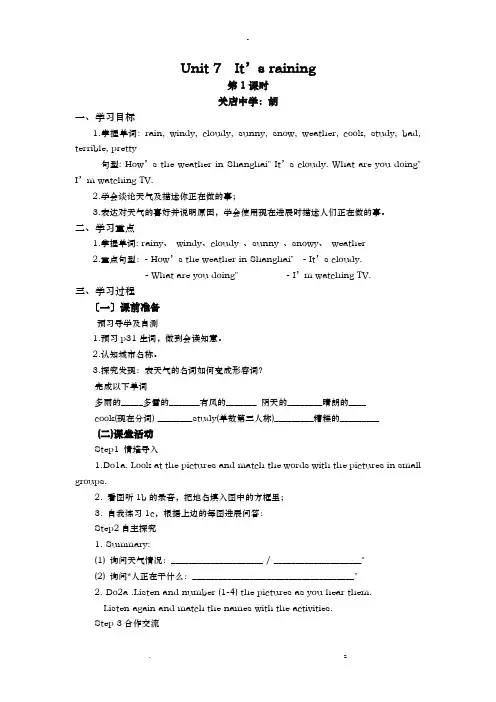
Unit 7 It’s raining第1课时关店中学:胡一、学习目标1.掌握单词: rain, windy, cloudy, sunny, snow, weather, cook, study, bad, terrible, pretty句型: How’s the weather in Shanghai" It’s cloudy. What are you doing" I’m watching TV.2.学会谈论天气及描述你正在做的事;3.表达对天气的喜好并说明原因,学会使用现在进展时描述人们正在做的事。
二、学习重点1.掌握单词: rainy、windy、cloudy 、sunny 、snowy、weather2.重点句型:- How’s the weather in Shanghai" - It’s cloudy.- What are you doing" - I’m watching TV.三、学习过程〔一〕课前准备预习导学及自测1.预习p31生词,做到会读知意。
2.认知城市名称。
3.探究发现:表天气的名词如何变成形容词?完成以下单词多雨的_____多雪的_______有风的_______ 阴天的________晴朗的____cook(现在分词) ________study(单数第三人称)_________糟糕的_________(二)课堂活动Step1 情境导入1.Do1a. Look at the pictures and match the words with the pictures in small groups.2. 看图听1b的录音,把地名填入图中的方框里;3. 自我练习1c,根据上边的每图进展问答:Step2自主探究1. Summary:(1) 询问天气情况:_____________________ / ____________________"(2) 询问*人正在干什么:_____________________________________"2. Do2a .Listen and number (1-4) the pictures as you hear them.Listen again and match the names with the activities.Step 3合作交流1. Do3a. Match the words with the faces in the bo*.2. Do3b. Pairwork.3. Talk about the weather with your friends in groups.Step 4课堂点拨1. How’s the weather" =What’s the weather like "都是用来询问天气状况的句型。
Unit 7 It’s raining.Section A (1a-2d)一、教学目标:1. 语言知识目标:1) 能掌握以下单词:rain, windy, cloudy, sunny, snow, weather, cook, bad, park,message, take a message, could, back, problem 能掌握以下句型:①—How's the weather in Beijing?—It's sunny.②—Can I take a message for him?—Yes. Could you just tell him to call me back?—Sure, no problem.2) 能用所学的知识描述天气情况。
3)描述正在发生的动作。
2. 情感态度价值观目标:教育学生善于观察天气,善于调整自己的情绪;了解世界各地的天气情况,增加世界观念。
知道大自然的力量是神奇而伟大的,我们应当好好学习,立志学好科学知识,为长大后探索神奇的大自然,打好基础。
二、教学重难点1. 教学重点:1) The vocabulary and useful expressions.2) —How’s the weather?—It's raining/ windy.3) —What are you doing?—I'm playing basketball.2. 教学难点:运用目标语言来对天气进行问答,并且会问答其他人正在进行的活动。
三、教学过程Ⅰ. Warming-up and Lead in1. Greet the Ss and check the homework.2. Watch a video program about the weather.Ⅱ. Presentation1. (Show some pictures of the weather)Let Ss look at the pictures and ask them how the weather is.Ss learn the new words and expressions with the help of the pictures.2. Look at the pictures in 1a. Then read the new words on the right. Ask the Ss tomatch the words with pictures.3. Check the answers.Ⅲ. Game (How's the weather?)1. (Showing some pictures on the big screen.) Ask Ss "How's the weather?"2. Ss guess and answer the question.Ⅳ. Listening1. Now let's look at the city names in the box in 1b. Please read after me.Ss read the cities after the teacher.2. Now, We’ll hear four conversations. Listen carefully, point out each city in thepicture as it comes upon the tape. Play the recording a second time. Ask Ss to write the name of the city in the picture of its weather.3. Check the answers.Ⅴ. Pair work1.Tell the Ss: If you are in one of the places in the picture above. Talk about theweather with your friends in another city on the phone.2. Make a model with a student like this:T: Hi! How's the weather in Beijing?S1: It's sunny.3. Ss work in pairs. Ask and answer about the weather in the cities.Ⅵ. Listening1. Work on 2a.Let's see what Joe's families are doing. Point to the 4 pictures.2. Ask Ss tell each person is doing in each picture. More attentions should be paidto the correct use of the Present Progressive Tense.3. Play the recording for the Ss to listen and number the pictures [1-4].4. Play the tape for Ss to check the answers.5. With the whole picture, get some Ss to tell the story of it.6. BrainstormingPlay the tape for another time. Then do a memory test.Ask Ss: What's Uncle Joe/Jeff/Mary/Aunt Sarah doing?What're Scott and Lucy doing?Is Jeff watching TV? etc.7. Let Ss match the names with the activities in 2b.Play the recording for the Ss to check the answers.Ⅶ. Pair work1. Look at the pictures and talk about the people in 2a with a partner.2. Ask a student the questions as a model:T: What's Uncle Joe doing?S1: He's playing basketball.3. Ss work in pairs. Ask and answer about the pictures.Ⅷ. Role-play1. Ask Ss to read the conversation and answer the questions:①What's Steve doing?②What's Rick's brother doing?Ss read the conversations and answer the questions. Then check the answers together.2. Let Ss role-play the conversation in pairs.IX. Language points.X. ExercisesHomework:一、总结有关天气的词汇。
第七讲Unit7 年级初一课时 2 课题 How much are these socks?教学目标短语和单词的熟练运用。
教学重难点单词和短语的熟练掌握考点短语的写和背课堂引入:1.Two BirdsTeacher: Here are two birds, one is a swallow, the other is sparrow. Now who can tell us which is which?Student: I cannot point out but I know the answer.Teacher: Please tell us.Student: The swallow is beside the sparrow and the sparrow is beside the swallow.两只鸟老师:这儿有两只鸟,一只是麻雀。
谁能指出哪只是燕子,哪只是麻雀吗?学生:我指不出,但我知道答案。
老师:请说说看。
学生:燕子旁边的就是麻雀,麻雀旁边的就是燕子。
一、新知讲解:单词much/m?t?/pron.&adj.许多;大量;多少How much...?(购物时)......多少钱?sock/s?k/n.短袜T-shirt/'ti:??:t/n.T恤衫shorts/??:ts/n.(pl.)短裤sweater/'swet?/n.毛衣trousers/'trauz?z/n.(pl.)裤子shoe/?u:/n.鞋skirt/sk?:t/n.裙子dollar/'d?l?/n.元(美国、等国的货币符号为$)big/big/adj.大的;大号的small/sm?:l/adj.小的;小号的short/??:t/adj.短的;矮的long/l?:?/adj.长的woman/'wum?n/n.女子Can I help you?我能帮您吗?need/ni:d/v.需要look/luk/v.看;看上去pair/pe?/n.一双;一对take/teik/v.买下;拿;取Here you are.给你。
Unit 7 How much are these socks?教材解读该单元的主题是shopping,单词主要是关于各种衣服、表示颜色的词以及部分表示数字的词。
通过大量反复的对话练习,掌握如何询问价格、谈论衣服、提供帮助、表示感谢。
学习方式涉及听说读写各个方面。
通过大量的对话以及结队活动、小组活动等任务型活动,让学生在重复模仿中学会对话,进行简单的分角色表演,在完成任务中完成语言学习任务。
语法部分主要是询问价格以及回答。
单元目标一、知识与技能1. 掌握词汇:socks、T-shirt、pants、shoes、shorts、sweater、bag、dollar、black、small、short、long、black、white、red、green、blue、big、numbers 10~31和指示代词this、that、these、those。
2. 掌握句型:How much is this T-shirt? It’s seven dollars.How much are these socks? They’re two dollars.You’re welcome.二、过程与方法通过对“购物”的讨论与学习,认识各种衣物,学会询问衣物的价格和答语。
学会提供帮助并对别人的帮助表示感谢。
能听懂关于购物的对话,能理解关于购物的短文,全面提高听说读写综合能力。
三、情感态度与价值观1. 学会询问价格并回答。
2. 培养学生在购物方面对价格的感知。
能认识到衣物有价格的高低,但没有好坏之分,不管我们的衣服值多少钱,只要大方得体、干净整洁,就是好衣服。
教法导航1. 利用图片和视频调动学生的兴趣和积极性,帮助学生直观清楚地认识各种衣物。
2. 将学生分为小组活动,教师指导小组成员完成教学任务。
3. 指导学生通过大量练习,由浅入深逐步掌握重点词汇及语法知识。
4. 听录音,指导学生完成相关练习,同时指导学生完成小对话,正确表达询问价格,1教师备课系统──多媒体教案回答,提供帮助,感谢他人。
第7单元It’s raining!类别课程标准要求掌握的内容话题The weather 天气Section A 单词rain v.下雨n.雨水 windy adj.多风的 cloudy adj.多云的sunny adj.晴朗的 snow v.下雪 n.雪 weather n.天气cook v.做饭 bad adj.坏的;糟的 park n.公园message n.信息;消息 him pron.他(he的宾格)could modal v.能;可以 back adv.回来;回原处problem n.困难;难题 again adv.再一次;又一次Moscow 莫斯科 Toronto 多伦多 Boston 波士顿短语ake a message 捎个口信;传话call (sb.) back (给某人)回电话no problem 没问题 have a good time 玩得开心right now 此刻;马上句型1.—How’s the weather? 天气怎么样?—It’s cloudy. /It’s sunny. /It’s raining. 多云。
/ 晴朗。
/ 正在下雨。
2.—How’s it going? 近来可好?—Great! / Not bad. /Terrible! 好极了!/ 还不错。
/ 糟透了!3. Can I take a message for him? 要我给他带口信吗?4.—Could you just tell him to call me back?你能否叫他给我回个电话?—Sure,no problem当然可以,没问题。
Section B 单词dry adj.干燥的 cold adj.寒冷的;冷的 hot adj.热的warm adj.温暖的 visit v.拜访;参观 Canada n.加拿大summer n.夏天;夏季 juice n.果汁;饮料 sit v.坐soon adv.不久;很快 hard adv.努力地adj.困难的vacation n.假期Europe n.欧洲 mountain n.高山 country n.国;国家skate v.滑冰 winter n.冬天;冬季 snowy adj.下雪的Russian adj.俄罗斯的 n.俄罗斯人;俄语rainy adj.阴雨的;多雨的 snowman n.雪人短语summer vacation暑假 study hard 努力学习be happy to 很高兴做某事 write to 给……写信on (a) vacation 度假 right for…适合……take a photo of 给……拍照 in the rainy weather在下雨天句型1. I’m having a great time visiting my aunt in Canada. 我在加拿大看望我的姑妈,并且玩得很开心。
新目标初一英语unit7教案
一.学情分析:本课是一个实用性较强的课,又与学生的生活经验和认知水平紧密相连,学生对本课时的学习将会体现出浓厚的兴趣。
另外本课时的新单词虽然很实用但却较多,学生在学习及使用单词的过程当中将会产生一些障碍。
在教学过程中,应注意1,单词的读音及is 和has的区别;2,tall, short 和 medium height; thin,heavy和medium build的教学应注意其相对性。
最后,任务的设置应有明确的目的并具有可操作性,这样才有利于提高实际语言的运用能力。
二.教学目标:1.知识和能力目标:本课时的语言目标为描述人的外貌;学会谈论身高、体重、发型;围绕语言目标,学生应掌握“What does he/she look like? What do they/you look like? He is…He has…”等句型;学习并掌握“like, look like, curly,long, medium, build ”等重点词汇。
2.过程和方法目标:学生通过看、听、说、写掌握并使用描绘人的外貌的句型和词汇。
学生通过完成教材和教师设置的各项任务,使用这一课时的目标语言获取并分享信息,自由谈论他人的外貌特征。
3.情感态度目标:学生讨论和完成任务的过程是学生合作与交流的过程。
另外,在谈论他人的外貌是应注意使用委婉语,礼貌待人。
不要以貌取人(We mustn’t judge people by appearance) 四,教学
重难点:描绘人的外貌句型和词汇;句型中is和have/has的区别。
四:教学手段;多媒体图片五:教学方法:(Teaching Methods) 呈现,归纳,讨论等(Scene teaching method Oral practice method Pairwork)六:教学过程(Teaching Procedures) Step I: Lead-in (1 minute) Show 2 pictures to lead in today’s topic。
Step II: Presentation (20 minutes) 1。
Show pictures to present one type of describing people’s looks (long hair)。
2。
Present the new word (long hair) and the target language through the pictures: What does he look like? She has long hair。
3。
Get Ss to drill the sentences by asking and answering the question: What does she/he look like? 4。
Use almost the same steps as above to present other types of describing people’s looks and make Ss drill the target language。
Step III。
Consolidation (8 minutes)。
1。
Ask several Ss to read these words,target language and describe the people’s looks according to the pictures (3minutes) 2。
Listening practice with a game—Bingo (5 minutes) (1)。
Get the class to do 1a quickly, then check the answer with whole class。
(2), Make sure Ss know what to do,
then play a game—Bingo by using these words and target language。
Step IV。
Practice (9minutes) 1。
Ask Ss to take out their photos and make dialogues like this: A: Is this your family photo? B: Yes, it is A: Who is your mother? B: She is medium height, has short curly hair。
She is thin。
A: Aha I find her,is it her? B: Yes, it is。
You’re clever。
What do your parents look like? A: My father…and my mum…Then ask several pairs to act their dialogues out。
2。
Invite one student to draw a picture of a person, and write down the description of the person Step V Summary (1minute)New words and target language。
The differences of “is and have/has”Step VI。
Homework (1minute) 1。
Copy the new words learned in this lesson 3 times。
2。
Write down the dialogue they’ve made in the class。